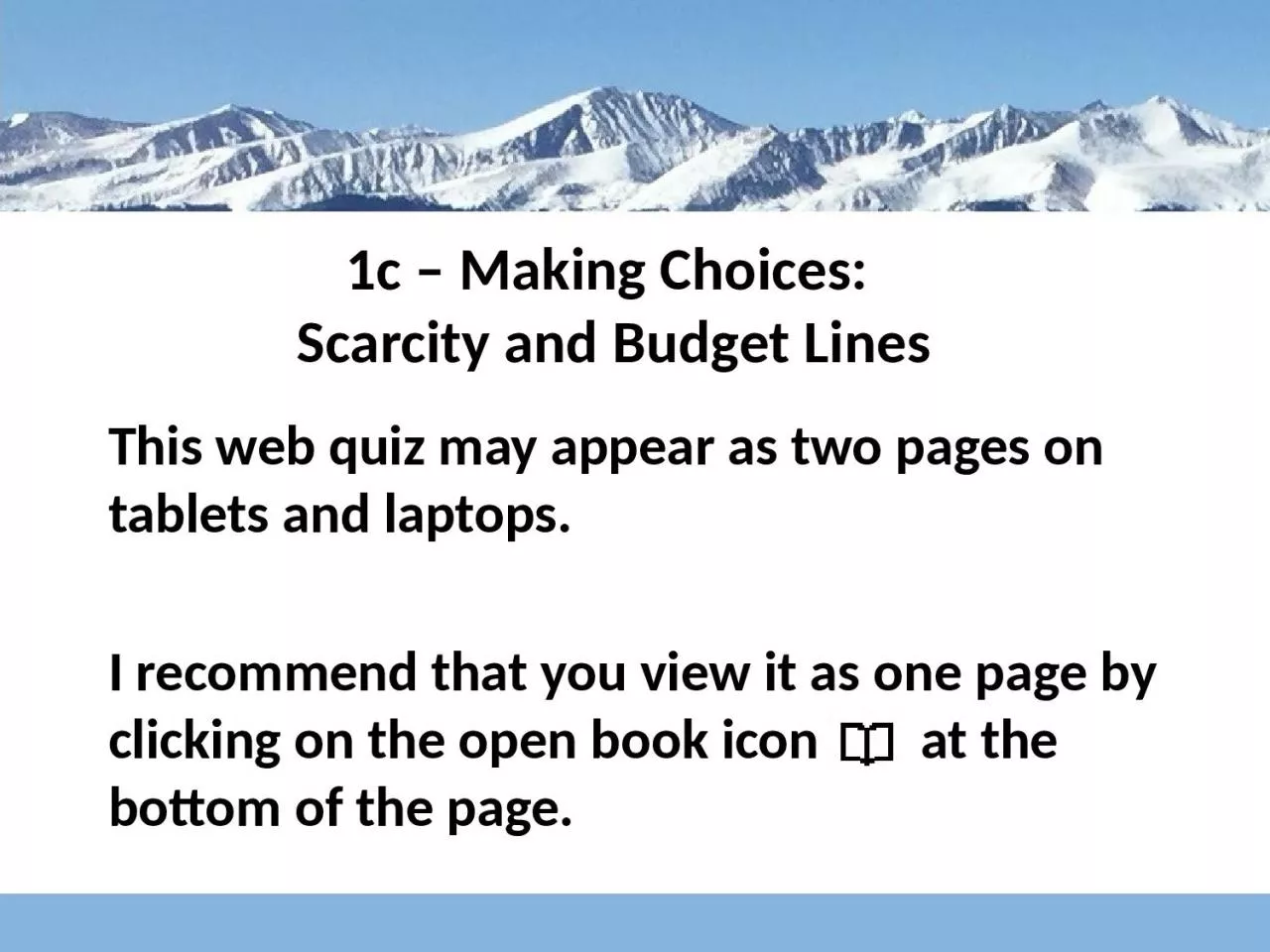

This web quiz may appear as two pages on tablets and laptops I recommend that you view it as one page by clicking on the open book icon at the bottom of the page Lesson 1c Must Know Outcomes ID: 1042649
Download Presentation The PPT/PDF document "1c – Making Choices: Scarcity and Bud..." is the property of its rightful owner. Permission is granted to download and print the materials on this web site for personal, non-commercial use only, and to display it on your personal computer provided you do not modify the materials and that you retain all copyright notices contained in the materials. By downloading content from our website, you accept the terms of this agreement.
1. 1c – Making Choices: Scarcity and Budget LinesThis web quiz may appear as two pages on tablets and laptops.I recommend that you view it as one page by clicking on the open book icon at the bottom of the page.
2. Lesson 1cMust Know / OutcomesDefine economics and describe the four components of the definition: social sciencechoicescarcitymaximizing satisfactionWhat are economic models and why do economists use them?Explain the importance of ceteris paribus in formulating economic principles.Differentiate between microeconomics and macroeconomics.Define and draw budget lines. Explain what happens to a budget line when income and prices change.How does the budget line illustrate the necessity of making choices?Define and give examples of the four types of resources (factors of production) and know the payment for each
3. 1cKEY TERMS: economics, economic model, microeconomics, macroeconomics, utility, rational choice, opportunity cost, benefit-cost analysis (marginal analysis), ceteris paribus (other things equal assumption), budget line, budget constraint, factors of production, land, labor, capital, entrepreneurial ability,
4. 1. Scarcity:is a problem only during a recessionis a problem only in developing countriesIs a problem only among poor peopleRequires that people make choices
5. 1. Scarcity:is a problem only during a recessionis a problem only in developing countriesis a problem only among poor peoplerequires that people make choices
6. 1. The opportunity cost of any particular choice is:The least expensive alternative to the choiceThe best alternative to the choiceThe price that one pays for the choiceThe most expensive alternative to the choice
7. 2. The opportunity cost of any particular choice is:The least expensive alternative to the choiceThe best alternative to the choiceThe price that one pays for the choiceThe most expensive alternative to the choice
8. 3. Economics is the study of:How businesses generate profitsHow society chooses to use its resourcesHow to more equitably distribute incomeHow money is used in our culture
9. 3. Economics is the study of:How businesses generate profitsHow society chooses to use its resourcesHow to more equitably distribute incomeHow money is used in our culture
10. 4. Economists use economic models:to maintain real-world complexityto appear as precise as the physical scientiststo understand how the real world worksto include every detail in their analysis
11. 4. Economists use economic models:to maintain real-world complexityto appear as precise as the physical scientiststo understand how the real world worksto include every detail in their analysis
12. 5. In economics, the term “ceteris paribus” means:The central variableHold all other variables constant“In the unlikely event that . . .”None of the above
13. 5. In economics, the term “ceteris paribus” means:The central variableHold all other variables constant“In the unlikely event that . . .”None of the above
14. 6. An example of a topic that microeconomists study is:a change in Ford motor company’s market sharea change in the unemployment ratea change in inflationa change in the rate of economic growth
15. 6. An example of a topic that microeconomists study is:a change in Ford motor company’s market sharea change in the unemployment ratea change in inflationa change in the rate of economic growth
16. 7. Which of the following is NOT one of the four types of resources?landcapitallabormoneyentrepreneurial ability
17. 7. Which of the following is NOT one of the four types of resources?landcapitallabormoneyentrepreneurial ability
18. 8. The budget line shows:The amount of product A that a consumer is willing to give up to get one more unit of product BAll possible combinations of two goods that can be purchased given money income and the prices of the goodsThe minimum amount of two goods that a consumer can purchase with a given money incomeAll possible combinations of two goods that yield the same level of satisfaction to the consumer
19. 8. The budget line shows:The amount of product A that a consumer is willing to give up to get one more unit of product BAll possible combinations of two goods that can be purchased given money income and the prices of the goodsThe minimum amount of two goods that a consumer can purchase with a given money incomeAll possible combinations of two goods that yield the same level of satisfaction to the consumerFor ALL graphs: Define, Draw, Describe the shape
20. 9. Any combination of goods lying outside of the budget line:Implies that the consumer is not spending all its incomeYields less satisfaction than any point on the budget lineYields less satisfaction than any point inside the budget lineIs unattainable given the consumer’s income
21. 9. Any combination of goods lying outside of the budget line:Implies that the consumer is not spending all its incomeYields less satisfaction than any point on the budget lineYields less satisfaction than any point inside the budget lineIs unattainable given the consumer’s income
22. 10. A shift in the budget line from cd to ab could be caused by:Decreases in the prices of both M and NAn increase in the price of M and a decrease in the rice of NA decrease in money incomeNothing. Budget lines do not shift.
23. 10. A shift in the budget line from cd to ab could be caused by:Decreases in the prices of both M and NAn increase in the price of M and a decrease in the rice of NA decrease in money incomeNothing. Budget lines do not shift.